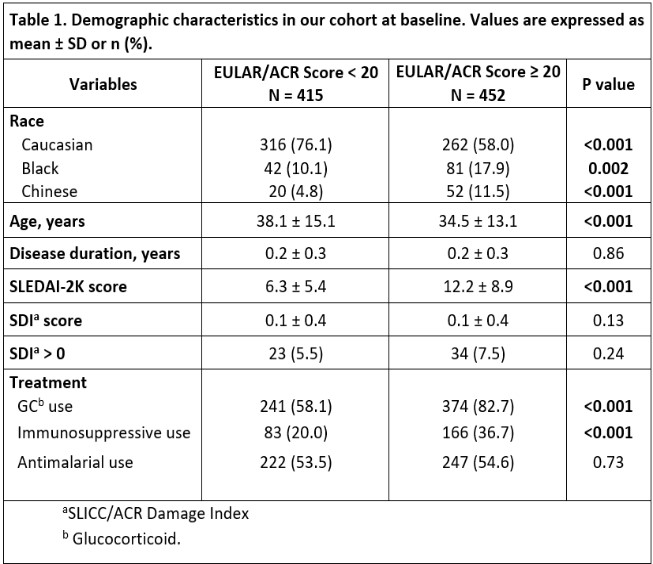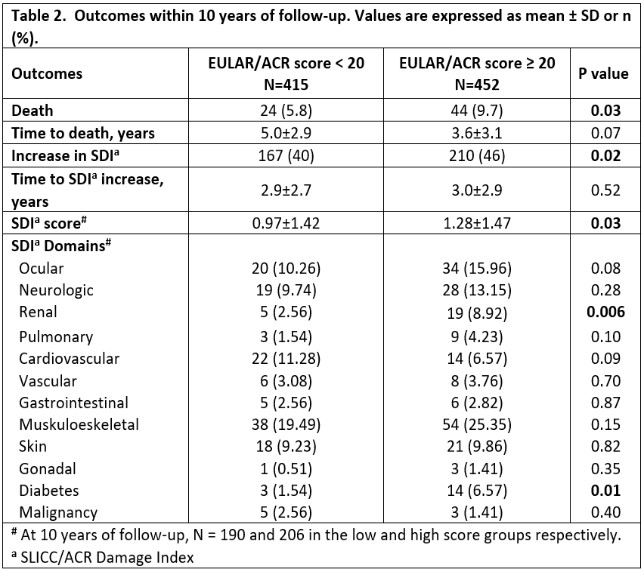Session Information
Date: Saturday, November 6, 2021
Title: SLE – Diagnosis, Manifestations, & Outcomes Poster I: Diagnosis (0323–0356)
Session Type: Poster Session A
Session Time: 8:30AM-10:30AM
Background/Purpose: We recently demonstrated that a EULAR/ACR classification Criteria score ≥ 20 predicts a higher disease activity throughout the first 5 years after diagnosis. Given that disease activity is associated with damage accrual and mortality, we aimed to determine the ability of a EULAR/ACR score ≥20 to predict these long-term outcomes.
Methods: Inception SLE patients recruited in the first 12 months after diagnosis were included.
For each patient a EULAR/ACR score was calculated based on the baseline clinical and laboratory information. The baseline information was obtained from the first 2 visits.
Patients were divided into 2 groups depending on their EULAR/ACR score < 20 or ≥20. In order to determine the ability of a EULAR/ACR ≥20 to predict damage accrual and mortality the following outcomes were assessed:
- Time to first damage accrual, defined as any increase in the SLICC/ACR Damage Index (SDI) and time to death within the first 10 years after SLE diagnosis, analyzed using Kaplan Meier survival curves. For damage accrual, death within the 10 years was used as competing risk. Multivariable Cox Proportional regressions was performed to calculate the risk.
- Mean SDI score at the 10th year of follow-up was calculated.
Results: A total of 867 inception patients were included. Table 1 shows baseline clinical characteristics of the cohort.
The proportion of patients who accrued damage within the first 10 years and the mean SDI at 10 years were significantly higher in the group of ≥ 20. When looking at the specific domains in SDI, the group with a score ≥ 20 at 10 years of follow-up had significantly more renal damage and a higher percentage of diabetes (Table 2).
On multivariable regression analysis, after adjusting for age and ethnicity, a score ≥ 20 continued to significantly predict damage accrual, HR 1.28 (1.04-1.57), p=0.02. When we excluded patients who had damage at enrollment the results were similar (Table 3).
Sixty-eight (7.8%) of patients died within the first 10 years of follow-up, the percent of deaths was higher in the group with a score ≥ 20, (Table 2). Individuals in the ≥ 20 group had twice the probability of dying compared to patients with the lower score, the hazard ratios with significant p values confirmed this finding (Table 3).
Conclusion: A EULAR/ACR score ≥20 is an indicator of damage accrual and mortality in SLE.
To cite this abstract in AMA style:
Whittall-Garcia L, Gladman D, Urowitz M, Su J, Touma Z, Johnson S. The New EULAR/ ACR 2019 SLE Classification Criteria: A Predictor of Long-term Outcomes [abstract]. Arthritis Rheumatol. 2021; 73 (suppl 9). https://acrabstracts.org/abstract/the-new-eular-acr-2019-sle-classification-criteria-a-predictor-of-long-term-outcomes/. Accessed .« Back to ACR Convergence 2021
ACR Meeting Abstracts - https://acrabstracts.org/abstract/the-new-eular-acr-2019-sle-classification-criteria-a-predictor-of-long-term-outcomes/



